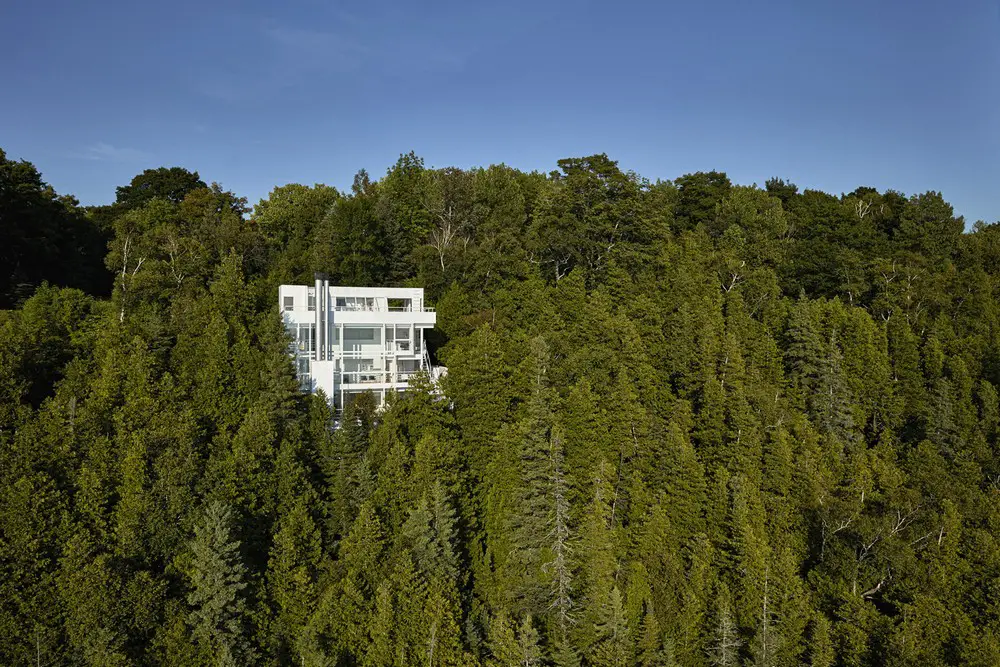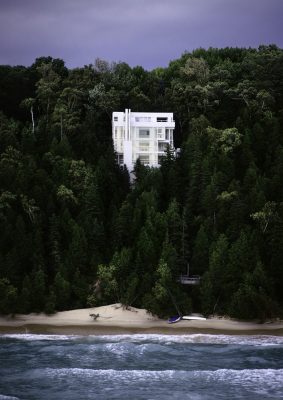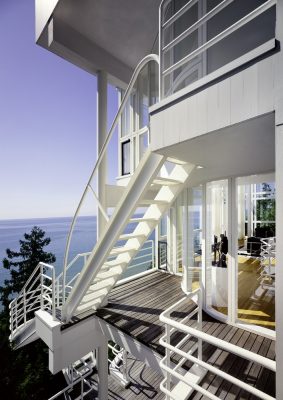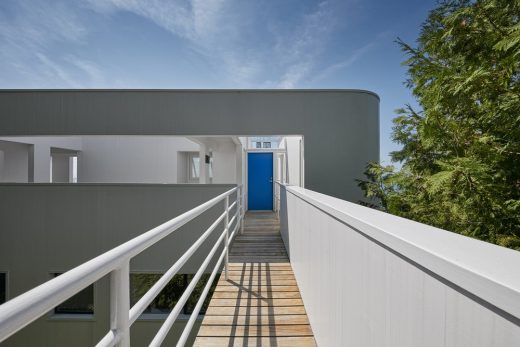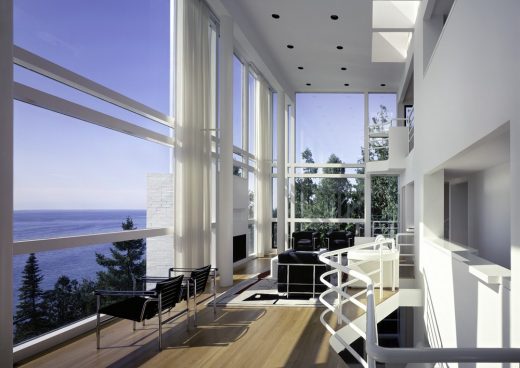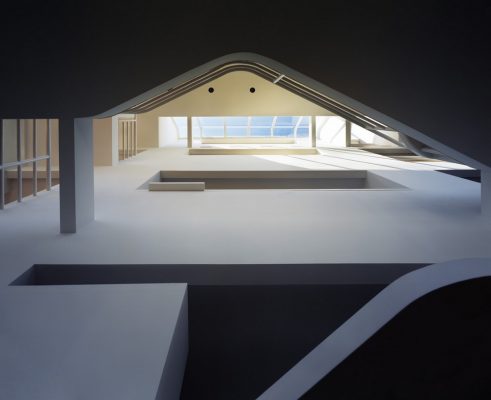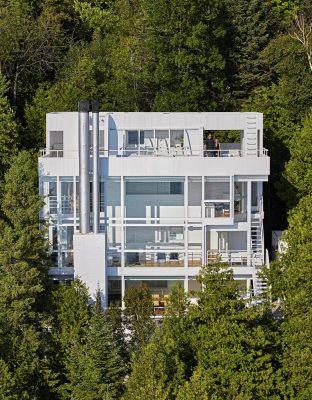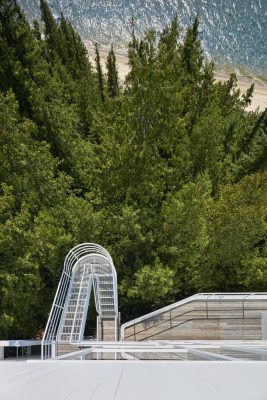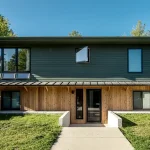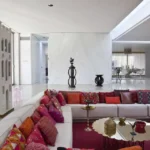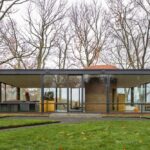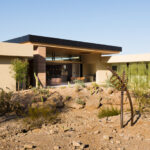Douglas House Harbor Springs Residence, Michigan Residential Development, USA Architecture
Douglas House in Michigan
American Residential Property at Harbor Springs design by Richard Meier & Partners Architects
Jul 12, 2016
Douglas House, Harbor Springs
Design: Richard Meier & Partners Architects LLP
Location: Harbor Springs, Lake Michigan, Michigan, USA
The James and Jean Douglas House
Douglas House
The Douglas House receives recognition of its historical and architectural significance by the National Park Service U.S. Department of the Interior. The house will now be included in the National Register of historic places, and it will become part of the selective list of cultural resources worthy of preservation in the United States of America.
Richard Meier comments: “One day I received a letter from a Mr. and Mrs. James Douglas inquiring if I would sell them the blueprints for the Smith House. I replied that while I was not prepared to sell the drawings I would certainly be willing to design a new house for them along similar lines. They accepted, and I started designing a house for a site that they had purchased in a residential subdivision in northern Michigan.
As it happened, the developer who had sponsored the subdivision insisted on reviewing the design of any house that would be built within its boundary. He asked me to submit photographs of my work, whereupon he immediately refused to permit a house designed by me since it did not have the prerequisite classic pitched roof. To my delight, the Douglases responded to this impasse by promptly selling the plot and looking for another site, and that was the beginning of a very gratifying collaboration.”
The Douglas House is dramatically situated on an isolated site in Harbor Springs, Michigan, that slopes down to Lake Michigan. So steep is the fall of the land from the road down to the water that the house appears to have been notched into the site. The entry to the house extends beyond the building envelope. As the sharp downhill grade of the land requires the house to be entered at roof level, it takes the form of a flying bridge that seems to shear off the top of the frontal plane.
The east side, facing the road, is the private zone, protected by a taut white membrane pierced by square apertures and horizontal strip windows. The roof-level bridge accentuates the unimpeded flow of space between this wall and the hillside, and is experienced as an activated void that further seals the private zone from the road.
“Usually when people enter a house, they expect the outside to be brought in, but in the Douglas House, the opposite occurs: you are transported outside, over the lake and into the trees. Visitors all depart with an experience they’ve never had before. It is truly a house of opposites: to leave the house for instance, you go up instead of down,” said Mr. Meier.
Once inside the entry vestibule, the views open to the west, down to both the living and dining levels, and out to a large roof deck overlooking Lake Michigan. As in the Smith and other houses designed by Richard Meier & Partners, the living-room fireplace is located directly opposite the entry, but in this case it is two stories below. At roof level, its stainless-steel smokestacks act as a foil to the entry and frame the view. Horizontal circulation moves along four open corridors, stacked one above the other behind a screen wall. Internal and external staircases provide vertical passage at the corners.
A skylight running nearly the full length of the roof-deck focuses sunlight into the living room, reinforcing the separation between the public and private sectors of the house. The living room virtually hovers in the landscape within three glass walls. The fireplace anchors the room, binding the floor to the lake’s horizon as if the water itself were cantilevered from the bricks. The house’s levels can be traced in the mullions of the glazing, which echo the dramatic horizontals of the lake’s surface, the horizon, and the shoreline. Vertical mullions fan out from the corners, carrying with them the lines of the great trees alongside the house. The unimpeded flow of space from inside out, so powerfully inscribed in the iconic Smith House, is rendered more profound.
Richard Meier comments: “Reflecting on the history and the design of the Douglas House I believe the architect is really the facilitator of creating something which goes on to have an existence that is much greater than itself and has a life that is longer than any of the people involved in the creation of it.
“In thinking about the ideas that go into making architecture one has to think about not just the context, the circumstances of the site, its history, the surrounding buildings, the topography, and the nature of the place in the public realm, but also about what it can be, what it will be, and how it will be meaningful for future society. With all of the changes that are taking place in the world today, it is important that architecture continues to move us aesthetically, as great architecture always has.
“We are deeply honored by this historic distinction of the Douglas House, and we are very grateful for all the dedication, care and supervision given by the current owners of the house. Michael McCarthy and Marcia Myers have returned the house to its original intent.”
Douglas House – Building Information
Major Building Materials: Wood frame and steel column structure, wood floors, wood roof, redwood exterior siding, gypsum wall partitions, and fiberglass insulation
Program: Private residence
Floors: 5
Site Area: 22,760sqm (245,000 SFT)
Floor Area: 418sqm (4,500 SFT)
About Richard Meier & Partners Architects
The work of Richard Meier & Partners is instantly recognizable and internationally respected. For over five decades, the Firm has been appointed to design important buildings, and it has successfully completed over 130 projects across North America, South America, Europe, and Asia. Among its best known works are: the Smith House in Darien, Connecticut; the Getty Center in Los Angeles, California; the United States Courthouse in Islip, New York; the Perry & Charles Street Condominiums in New York City and the Jubilee Church in Rome, Italy.
Richard Meier & Partners is led by founder and Pritzker Prize laureate Richard Meier and six partners – Michael Palladino, James R. Crawford, Bernhard Karpf, Vivian Lee, Reynolds Logan, and Dukho Yeon. The offices in New York and Los Angeles employ a multicultural staff of talented professionals practicing architecture, urbanism, product design and exhibition design. The quality of the work has been recognized with almost 300 design awards, including major awards from the American Institute of Architects (AIA) and the Royal Institute of British Architects (RIBA).
About The National Register of Historic Places
The National Register of Historic Places is the official list of the Nation’s historic places worthy of preservation. Authorized by the National Historic Preservation Act of 1966, the National Park Service’s National Register of Historic Places is part of a national program to coordinate and support public and private efforts to identify, evaluate, and protect America’s historic and archeological resources.
Douglas House in Michigan information / images received received 120716
Richard Meier & Partners Architects on e-architect
Address: 3490 South Lake Shore Drive, Friendship Township, near Harbor Springs, Michigan, USA
USA Architecture
American Architecture – Selection
Farnsworth House, Plano
Mies van der Rohe
Farnsworth House
University of Iowa building, Iowa City
Design: Steven Holl Architects
American University
Comments / photos for the Douglas House Harbor Springs – Michigan Architecture page welcome

